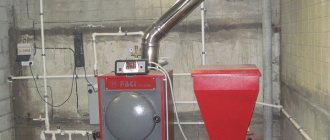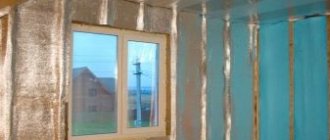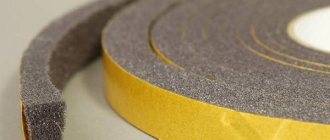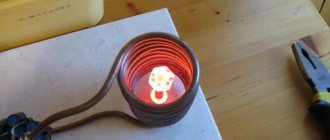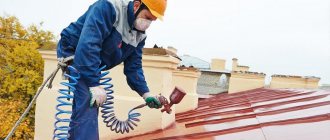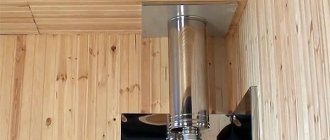Master Flash for a chimney: types, design and technological installation rules - House and site
The construction of a house, country house or other building of any kind is impossible without the use of ducting through the roof to release air from the chimneys.
To prevent dirt and precipitation from penetrating under the roofing material into the passage area, it is necessary to seal the resulting gap.
The ideal solution to this problem is to use Master Flush on chimneys.
Advantages of Master Flash penetration
Master Flash flexible products have won the trust of craftsmen and, thanks to their undeniable advantages, have become the most popular devices for isolating the gap between the chimney and the roof:
- Elasticity. Thanks to its plasticity, “Master” creates a high-strength seal around the pipe and does not leave a gap in the roof.
- Versatility. Used for roofs of any slope and shape. The roofing material can be very diverse: slate, roofing membrane, onyulin, metal tiles, profiled flooring.
- Fire resistance and resistance to high temperatures. After thermal linear tension, the product acquires its original shape and size. The maximum temperature at which Flash Flash Flash Flash can be used is 230-240 C°. Therefore, rooms can be equipped with heaters operating on all types of fuel.
- Condensation. Reliably protects the gap from moisture penetration and prevents the possibility of leaks.
- Durability and longevity. Resistance to strong temperature fluctuations, chemical and mechanical influences ensures long-term operation. The manufacturer guarantees the flawless operation of the product for up to 30 years. Typically, replacement is not required during the entire life cycle of the product.
- Basic installation. Allows you to install Master Flash even for beginners. The assembly process does not require special equipment or tools.
It should be noted that flexible eliminates the need for additional sealing in the penetration block and can significantly reduce the volume of construction materials and reduce financial costs.
Assembly
The Flash Wizard is installed as follows.
First, cut off the upper part so that the diameter of the resulting part is approximately one fifth less than the chimney pipe. This will ensure a tight fit. The resulting structure is placed on the pipe with the base down and moved along the pipe until it fits against the roof. When installing master flush on corrugated sheets and metal tiles, it is better to use a rubber penetration.
The next step will be to secure the resulting structure with sealant. At the very end, you should screw it to the roof using self-tapping screws.
Master flush, or kryza, perfectly performs the function of protecting the attic from precipitation
There are several tricks when installing master flash.
To make it easier to thread the pipes through the roof, cover them with soapy water.
This will make pulling easier. If you were unable to immediately successfully cut a hole in the master flash, you can try to use it, sealing it tightly with a clamp. When buying a sealant for master flush, make sure that it is resistant to moisture. There should not be too many self-tapping screws, since in any case the sealant will someday begin to let moisture through, and then it will seep through the holes. Try not to screw self-tapping screws into recesses in the roofing material, as this is where precipitation flows. When installing the master flush on a chimney ridge, place its top under the flashing.
There are some features that you need to know before installing master flush on metal tiles. And other roofing materials that are installed with one sheet overlapping another. When performing installation in this case, you need to bring the upper part of the canopy under the nearest adjacent sheet. By performing this maneuver, you will achieve free flow of liquid regardless of the tightness of the penetration connection. This way you can increase the service life of the connection.
If you use a chimney without insulation, as well as boilers running on solid fuel, temperatures can reach 600 º, which can lead to failure of the roof. How to install the master in this case? You need to select a pipe whose size exceeds the diameter of the chimney by about 10-12 cm. Its length should be up to 50 cm, or you can use regular galvanized metal. In the place where the chimney passes through the roof, it must be covered with basalt, and a selected sleeve must be placed on top. The master flash is installed, the dimensions correspond to the sleeve used. The open section of the insulation at the top is covered with a hopper, which is made of galvanized steel. You can attach it using a clamp.
The canopy with fastener is installed according to the following scheme. The top of the cone is also cut to a size 20% smaller than that of the pipe. Then the clasp is removed from the lock. The cuff is wrapped around the pipe, its sides are connected. Then the fastener returns to its place, the teeth tighten. The sealant is then applied to the appropriate area of the roof. Then the fastener and all places that need to be insulated are treated with it.
Having completed the installation, install the plate, thus giving the structure a finished look.
Thus, installing a master flush with your own hands is completely easy to do even for a novice, inexperienced builder. After all, all the tools needed for it can be easily found in many construction stores or even made with your own hands. This will not require special time or material costs from the master. At the same time, the installation of such a device will reliably protect the roof from precipitation, which otherwise could lead to unpleasant consequences.
Necessary materials
Before installing the master flush on the roof, check its contents. You will need:
— Master flush for a pipe of the appropriate diameter. When choosing, also focus on the temperature of the exhaust gases, since the choice of material from which the roof is made depends on it.
Advice! When choosing a penetration, keep in mind that a flash master with a reinforced base has a longer service life, but provides insufficient adhesion when installed on metal tiles, corrugated sheets or other embossed roofing materials.
— A plate used to protect the wing from sunlight. It can be purchased at building materials stores or made with your own hands. It looks like an ordinary plate without a bottom.
— Screwdriver, self-tapping screws, metal scissors and heat-resistant silicone sealant
About the conditions of use
An elastic rubber penetration would be an excellent option for ensuring reliable waterproofing in the chimney passage area. But it will not be appropriate in all cases. Experienced experts say that such a device is suitable for equipping the following smoke exhaust channels:
- Sandwich chimneys. These pipes have two contours made of durable galvanized steel, between which there is a layer of thermal insulation, most often represented by basalt fiber. This material retains heat through the inner pipe, which is why the outer part of the chimney does not warm up much, remaining practically cold. Optimal waterproofing of sandwich pipes - rubber models.
- Stainless steel chimneys, through which combustion products are discharged into the external environment when heating premises, are distinguished by the fact that they heat up very much. It is customary to fill the gaps between them and the roofing surface with heat-resistant penetrations made of silicone. In this case, master flush rubber models are also suitable, but if the chimney is powered by a gas condensing boiler.
Installation of roof sealant
Installation of master flash is simple in technology. However, there are some points that need to be taken into account.
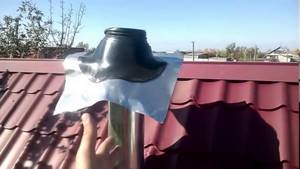
On a flexible basis
On metal roofs, cuffs with a flexible base are used. The installation itself looks like this:
- Determine the location of the cut. Do not forget that the cutting diameter will be 20 percent smaller than the chimney;
- To ensure that the cut part is even, find roofing scissors;
- We soap the chimney pipe with soap or moisten it with water. This is done to make it easy to put on the cuff;
- The installation is done, then we draw lines along the edges of the base;
- We lift the seal and apply the adhesive;
- We press;
- We apply sealant where needed.

Master Flush with hard rig
If there are metal strips at the edge of the seal, then installation is similar to the installation of soft equipment. The following items are added. Before installation, the base coating must be profiled so that it adheres well to the roof. To work, you will need hexagon-shaped self-tapping screws. Fasteners are screwed onto the bottom of the profile.

Seal for repair
A special seal design for roofs with a technological gap is needed when it is not possible to attach a seal to the chimney. They are often used for repair work on old chimneys.
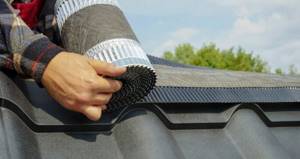
The installation will be like this:
- Using strong scissors, cut off the upper cone to less than 20% of the chimney cross-sectional size.
- Unscrew the shutter and wrap the pipe.
- Align the gap in the seal and close the locking system.
- Raise the edges of the base to apply silicone sealant to the roof.
- Press everything with force, spread the adhesive solution on the desired areas, the locking system.
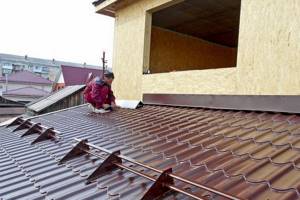
Installation on tiles, slate
For tile or slate roofs, seals are made with a lead or aluminum flange. The cone system is also cut off. This is done in order to ensure good adhesion of the remaining cone to the chimney.

The top of the iron base is tucked under the roof, and the bottom and side of the material are placed under the roof. To prevent precipitation from getting under the covering, the top strip must be folded. Upon completion of the work, it is necessary to cover the joints with problem areas with silicone.
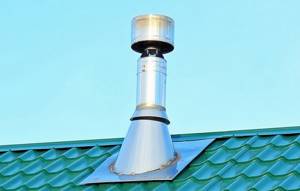
We put the master flash on the corrugated sheet
Installation of master flush on corrugated sheets is carried out in the same way as installation on a tile roof.

When installing, remember the following recommendations:
- In order for the seal to pass through the pipe easily, you need to coat the pipe with a substance that will support sliding.
- If you made a mistake with cutting a hole on the cone, well, you need to throw out the element.
- We take waterproof sealant for sealing. We screw screws on top of the sealant. As time passes, the sealant will perform its duties worse. The self-tapping screws will come to work. But, you don’t need to screw in a lot of screws. A large number of holes for screws increases the likelihood of moisture getting inside.
- When we place the kriza on the ridge, its top needs to be placed under the ridge cap.
- If the pitched covering is not uniform, with overlaps, you need to move the top of the seal under the adjacent part. This action promotes continuous flow of water, regardless of how well the roof sealing is done. This will ensure long, continuous operation.
- Installation of master flash on corrugated sheets is carried out similarly to a tiled roof.
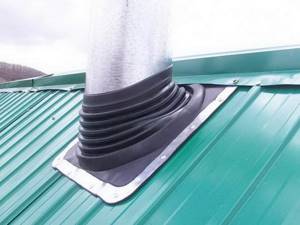
Roof penetration sealant made of EPDM (+185 C)
The Master Flash roof penetration is compatible with all types of roofing. Goes well with corrugated roofing surfaces. Made of thermo silicone, EPDM rubber (vulcanized). A huge selection of options for use: cable ducts, ducts, ventilation pipes, chimney pipes.

The roof is reliably protected from water and snow. Guaranteed heat resistance of vulcanized EPDM rubber: +185C

Equipment
The sealing product consists of the following elements:
- A flexible cuff, which is a truncated rubber cone. The cone is usually made of silicone or ethylene propylene materials. The cuff serves to connect the pipe to the roof deck. In the upper area, the cone fits tightly to the chimney pipe, and in the lower area it is connected to the base of the sealing structure;
- The flange serves as the base of the structure and is made of the same materials as the cone. Can also be made of galvanized steel or aluminum. The base of the flanges has special aluminum strips for mounting on the deck. This gives the structure the tightest possible fastening.
For a pitched roof, special penetrations with cuffs located at a certain angle to the flanges are purchased. On the cone of such a device, corrugations with gradations in diameter are clearly visible. Such corrugations help change the slope of the penetration in the required direction.
Characteristic advantages
Elastic protective products, which can be used to easily seal a pipeline passage on the roof, are highly appreciated by craftsmen. They have replaced many traditional materials previously used to seal gaps. Do-it-yourself flash master is a task that even an inexperienced person can handle, and all thanks to certain qualities of the device:
- Elasticity. Rubber penetrations are very flexible and fit tightly to the pipe, enveloping it on all sides. Such products fit well even on profiled material, which is used to cover roofs with any slope and various shapes.
- Tightness. Reliable protection of gaps is provided from leaks through which atmospheric moisture can enter inside.
- Simple and uncomplicated installation. One person can complete the described task in a short time; no additional help is required.
- Versatility. Master Flash is installed on roofs covered with slate, metal tiles, corrugated sheets, bitumen shingles and others.
- High strength indicators. The structure of the material is porous and quite dense, withstands large mechanical loads.
- Durability. Rubber penetrations are not damaged for a long time and do not need to be replaced due to their resistance to chemical environments and temperature changes.
- Operation at high temperatures. The maximum permissible value at which silicone insulation for the chimney inlet can work is 240°C. Such heat resistance allows the described devices to be used when equipping heating systems operating on various fuels.
Installation Features
The master flush for the chimney can be installed on any roof format. Whether it is a sloped pitched roof or a flat one, as well as for any type of roofing material.
To ensure maximum contact with the pitched roof, you can use a special master flush, in which the “skirt” from the base is located at an angle, which makes installation and fastening easier.
When using a conventional vertical masterflush on a pitched roof, it is necessary to choose a larger model, because on the passage it will be installed in an inclined position and block the pipe in an ellipse when viewed in cross-section.
All work on installing the seal can be performed at any time of the year and in any weather. Minimum tools required. If everything is done correctly, the result is a tight connection with the pipe and a strong, reliable connection with the roof.
What it is
This device is a base in the shape of a square or circle, in the center of which rings rise, one after another. Moreover, each overlying ring is smaller in diameter than the previous one. In general, the material resembles a cone.
The base can be made of silicone or special rubber. Silicone can withstand high temperatures, approximately 350 degrees. But the melting of ordinary rubber begins at a temperature of 180 degrees. Therefore, in terms of heat resistance, silicone prevails over rubber. But, if you look at the ability to withstand ultraviolet exposure to sunlight, then rubber has an advantage. It does not collapse or deform under the influence of ultraviolet rays, unlike silicone.
But in the case of silicone, this problem can be solved, since there are special devices that will protect master flash from the harmful effects of ultraviolet radiation. The base of the master flush may also include aluminum. This metal gives it strength and promotes uniform pressure distribution.
Estimated cost
The cost of a master flush depends on what material it is made of. If the base is silicone, then such materials are more expensive than those based on rubber.
Prices for silicone wings range from 1,500 rubles to 3,500 rubles per piece. The price depends on the diameter and the size of the material.
Prices for rubber roofs range on average from 255 rubles to 600 rubles per month.
That's all! As you can see, master flush is an inexpensive material. It should be remembered that if everything is done in accordance with the rules, the gap will be closed hermetically, which will further prevent water from entering under the roof.
Also, when working at height, one should not forget about safety rules.
Master Flash for a chimney with your own hands - device and installation
Installing Master Flash is a fairly simple process. This was mentioned above. But, there are some nuances that you need to know about.
On a flexible basis
Seals with a flexible base are used on metal roofs.
Installation process:
- You need to choose a place for the cut. We must not forget that it should be 20 percent narrower than the diameter of the chimney.
- For this you need roofing shears. Try to keep the cut part straight.
- The surface of the chimney must be moistened. Then, tighten the seal onto the pipe.
- After installation on the roof, you need to draw a line along the edges of the base.
- Lifting the seal, apply adhesive.
- Press.
- Apply sealant to all required areas.
You need to choose an adhesive based on the type of roof covering.
Split roof seals are necessary in cases where it is impossible to fit the insulation onto the pipe. They are typically used to repair outdated chimney insulation.
- Using powerful scissors, you need to cut off the top of the cone 20% smaller than the diameter of the pipe.
- Open the lock and wrap the chimney.
- Connect the cut of the seal and close the lock.
- Lift the edge of the base to apply silicone sealant to the roof.
- Press everything down and apply glue to the required areas and to the lock itself.
For tile or slate roofs, seals with an aluminum or lead flange are produced. Their cone is also cut off to ensure a tight fit of the cuff to the pipe. The top of the metal base is placed under the roof, the lower and side parts are laid on the roof. To prevent moisture from getting under it, you need to bend the top edge. Finally, you need to fill the problematic joints with silicone.
You can learn about the installation of Master Flash using videos. Basic rules for installing pipe seals.
A distinctive feature of the Master Flash sealing system is its speed and ease of installation. In addition, they will allow you to save significantly, provide reliable waterproofing and last a long time. Another convincing argument is that you can install them yourself.
At the point where the chimney exits onto the roof, a gap forms between them, which, if not eliminated, will lead to moisture getting under the roof. The size of such a gap can be 3-5 cm. Traditionally, bitumen, cement or various sealants were used to eliminate it. However, such protection is short-lived and not reliable enough. To eliminate all these shortcomings, a master flush for the chimney is used. Another name for this device is rat or otter.
Algorithm of actions for the device
The chimney is installed and fixed in the base area.
During the construction of the canopy, it will be necessary to dismantle the pipe canopy, if it was already attached to it.
Next, perform the following steps:
- The size of the ring on the penetration is determined. It should be 20 percent less than the diameter of the chimney. Using a sharp knife, cut to the desired size. If the gap is unsuccessfully cut, do not rush to throw away the Master. You should try to correct such a flaw using a tightly installed clamp;
- The prepared Master pulls himself onto the pipe and with force lowers himself to the roof level. To make sliding easier, you can use soapy water as a lubricant;
- In the case of making a roof covering from ondulin, tiles, slate and other covering materials laid overlapping, the upper section of the base of the otter must be moved under the adjacent, outermost component of the insulation. This will create conditions for free drainage of water regardless of sealing;
- A moisture-resistant sealant or bitumen is applied under the base, and the flange is secured with self-tapping screws with a large press cap to the roof and sheathing. The distance between the screws should be maintained at 3.5 cm.
Expert advice: you should not screw in a large number of screws, since over time the sealant will gradually begin to lose its insulating qualities, and moisture will begin to enter through multiple punctures from the screws.
It is not recommended to screw self-tapping screws into depressions in the roofing material through which water flows. The flexible, sealing element can be easily bent to fit the roof profile and attached with minimal gaps. This completes the installation process.
In rare cases, a tight fit of the roof to the pipe is not observed. In this situation, the edges of the seal should be tightened with a clamp. This state of affairs serves as proof that the Master Flush was not selected accurately or the installation was carried out with errors.
Such auxiliary parts can be easily completed and installed with your own hands, or can be purchased at specialized construction stores. Such a “plate” is simply strung on the chimney on top of the otter. The size of the metal pad must be accurately selected to prevent it from oscillating due to wind.
The maximum operating temperature of Master Flash shows that the gasket cannot be used on every chimney. The otter will behave well if the chimney is insulated with a sandwich or on a chimney without insulation, which will heat up to no more than 100 degrees.
Expert recommendation: to avoid unpleasant situations - ignition or melting of the “master” during soot burning in an uninsulated pipe (temperature can reach 500-600 degrees), it is necessary to first perform thermal insulation work on the chimney.
For this purpose, basalt fiber is used, which is coated with galvanization.
According to numerous reviews, the widespread use of Master Flash roof seals is due to the convenience and speed of installation. Important advantageous factors are the affordable price, reliability of insulation, and long service life.
And there is no point in attracting highly qualified specialists or additional workers, since the instructions for the seals clearly and clearly describe the installation process, which any layman can handle.
Watch the video in which the master explains how to properly install and secure Master Flash for a chimney:
Installation method
It is assumed that the passage hole in the roof has already been prepared, and it is 10% larger in diameter than the pipe. The chimney is already in place and fixed at the bottom. If the visor is already attached to it, then it will have to be removed while the master flush is being installed.
Master flush is a universal solution that can be suitable for pipes of various diameters. After selecting a suitable model, it is necessary to cut off the top or excess rings so that the resulting internal diameter is 20% smaller than the external size of the pipe.
Next, it is put on over the pipe and lowered with force to the roof surface. If you have difficulty moving along the chimney, you can use a soap solution as a lubricant.
Installation instructions for master flush chimney
If the roof is made of tiles, slate or any other material made up of individual elements with overlap, the upper part of the master flush is placed under the previous row of material, and the lower part is secured with self-tapping screws.
Thanks to the flexibility of the base, the seal can be easily bent to the shape of the roofing material and secured with minimal gaps.
For flat roofs and roofs formed by sheet material (roofing felt, corrugated sheeting), the edges of the base are coated with sealant or bitumen and pressed to the roof with self-tapping screws with a wide press head.
There is no need to additionally reinforce the structure or seal it. All work on sealing the chimney passage ends here. In some cases, if the seal does not fit tightly to the pipe, you can grab the edge with a clamp and thereby compress the silicone ring. However, this may already indicate that the selection of the master flush was made, perhaps incorrectly, or errors were made during installation.
What is a flash master
The problem of leaks can be radically solved with the help of a special elastic penetration - flash master. This device looks like a round or square base, in the center of which there is a set of rings installed one after another, in such a sequence that each subsequent one is smaller in diameter than the previous one, so that together they form a cone.
The material for the base can be either silicone or special rubber. The advantage of the first is the ability to withstand elevated temperatures, up to 350 degrees, while rubber melts already at 180.
But silicone is destroyed and deformed under the influence of ordinary ultraviolet rays from the sun.
The design of the flash master also includes aluminum elements, which impart rigidity to its base and evenly distribute the load on the system.
Such a flash system must have the following set of characteristics:
- Easy installation, allowing you to install such a structure yourself without inviting a specialist.
- Acceptable price.
- Durable and able to withstand both very low and very high temperatures. It also produces flexible materials that are resistant to corrosion and other impacts. Silicone models can work in conditions of 300 degree heat.
- Tightness ensured by the tight coverage of the pipe by the upper ring of the cone.
- The flexibility of the design allows it to be mounted on any roofing materials, including tiles, metal tiles, corrugated sheets, slate and on any roof structures - straight or sharply pitched.
All flash seals are divided into two types:
- Straight, which is a cone with rings placed relative to the base at an angle of 90 degrees and intended for installation on surfaces parallel to the ground.
- Angular, used to seal roofs with slopes, using a cone made of rings protruding at an angle of 30 or 45 degrees.
The flash master is designed to be installed on the roofing, so that its rings tightly compress the pipe section, so that the opening between the roof and the pipe is hermetically sealed from precipitation.
This design can be installed both during the installation of pipes and after their installation, for which some products even have special cuts.
Structural properties of the seal
Roof seals are replacing pipe flashings that have been used for several decades. In design, these two products are little different, but modern devices consist of two main parts:
- Flexible cuff . It looks like a truncated rubber or silicone cone with markings. The cuff provides a tight seal between the pipe and the roof, preventing moisture and dust from penetrating inside. After installation, the upper part of the cone tightly closes the sandwich chimney. The lower part of the system is connected to the flange.
- Flange _ It looks like a round or square skirt. The raw materials for its production are rubber, silicone, lead, aluminum or galvanized sheet. When installed on a roof with large embossed corrugations, the silicone or rubber base is equipped with aluminum strips around the perimeter. This allows the flange to fit as tightly as possible to the surface.
On pitched roofs, the seal cuffs are placed at an angle to the base. Corrugations increase the accuracy of pipe cutting. This allows you to change the angle of inclination of the seal according to the manufacturer’s parameters.
You can distinguish Master Flash for installation on flat roofs by the location of the imaginary central axis of the cone. To do this, it is mentally drawn strictly perpendicular to the surface of the base.

